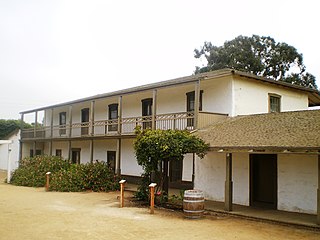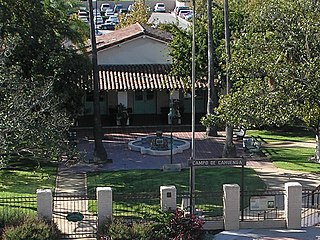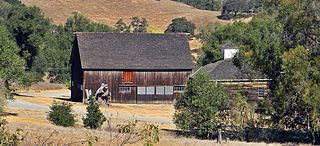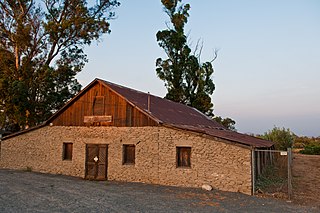
The Peralta Adobe, also known as the Luis María Peralta Adobe or the Gonzales-Peralta Adobe, is the oldest building in San Jose, California. The adobe was built in 1797 by José Manuel Gonzeles, one of the founders of San Jose, and is named after Luis María Peralta, its most famous resident.

The Rancho San Andrés Castro Adobe is a historically and architecturally significant house located in the Pájaro Valley, California. The two-story Rancho San Andrés Castro Adobe is a historic rancho hacienda that was built between 1848-49.

The Olivas Adobe in Ventura, California is an adobe structure built in 1837 by Raymundo Olivas on the north bank of the Santa Clara River about a mile from the estuary where it flows into the Santa Barbara Channel.

The Campo de Cahuenga, near the historic Cahuenga Pass in present-day Studio City, California, was an adobe ranch house on the Rancho Cahuenga where the Treaty of Cahuenga was signed between Lieutenant Colonel John C. Frémont and General Andrés Pico in 1847, ending hostilities in California between Mexico and the United States. The subsequent Treaty of Guadalupe Hidalgo of 1848, ceding California, parts of Colorado, Nevada, New Mexico, and Arizona to the United States, formally ended the Mexican–American War. From 1858 to 1861 the Campo de Cahuenga became a Butterfield Stage Station.

Rancho Petaluma Adobe is a historic ranch house in Sonoma County, California. It was built from adobe bricks in 1836 by order of Mariano Guadalupe Vallejo. It was the largest privately owned adobe structure built in California and is the largest example of the Monterey Colonial style of architecture in the United States. A section of the former ranch has been preserved by the Petaluma Adobe State Historic Park and it is both a California Historic Landmark and a National Historic Landmark. The Rancho Petaluma Adobe State Historic Park is located on Adobe Road on the east side of the present-day town of Petaluma, California.

Olompali State Historic Park is a 700-acre (2.8 km2) California State Park in Marin County, California. It is constituted of the former Rancho Olómpali and was the site of the famed Battle of Olómpali during the Bear Flag Revolt. Rancho Olómpali was purchased by the Californian government in 1977, which turned it into a public park.

The Dana Adobe & Cultural Center or "Casa de Dana" is a historic landmark in Nipomo, California. It was the home of Boston sea captain William Dana, who in 1837 was granted the 37,888-acre (153.33 km2) Rancho Nipomo in Southern California. Captain Dana hosted figures such as Henry Tefft and John C. Fremont in his Nipomo home, which also served as an important exchange point on California's first official mail route between Monterey and Los Angeles.

The Larkin House is a historic house at 464 Calle Principal in Monterey, California. Built in 1835 by Thomas O. Larkin, it is claimed to be the first two-story house in all of California, with a design combining Spanish Colonial building methods with New England architectural features to create the popular Monterey Colonial style of architecture. The Larkin House is both a National and a California Historical Landmark, and is a featured property of Monterey State Historic Park.

This is a list of the National Register of Historic Places listings in Monterey County, California.

The Hill–Carrillo Adobe, also known as Carrillo Adobe is a historic structure in Santa Barbara, California. Built in 1825 and 1826, it was listed on the National Register of Historic Places in 1986. It is also registered as a California Historical Landmark site (#721) as well.

The Collinsville Masonic Temple is a historic Masonic building located in Collinsville, Illinois. It houses Collinsville Lodge No. 712, A.F. & A.M, which was established in 1872 as the city's chapter of the Freemasons. The building was constructed in 1912; prior to then, the Masons had met in rented buildings. The Classical Revival building's front facade features a brick entablature and pediment supported by four two-story Doric columns. The Masonic Temple is the oldest fraternal meeting house in Collinsville which is still used by the organization which built it.

The Don Fernando Pacheco Adobe is located at 3119 Grant Street in Concord, California.The Fernando Pacheco Adobe is the only Concord landmark listed in all three Historical Registries: entry on the National Register occurred on June 6, 1980; the California Registered landmark number is 455; and the Concord Historical Landmark designation is 1-26-26/5458. The Adobe was built by Don Fernando in the early 1850s as the base of operations for his growing ranch activities, and as his family's formal residence. Fernando was the oldest son of Don Salvio Pacheco. He was born on May 30, 1818, while his father was assigned to a Militia-Guard unit at the Pueblo of San Jose. At age 17, he was sent to take possession and mark the boundaries of his father's 17,921 acre land grant. Fernando was given 1,500 acres as initial share of the rancho. He subsequently married Pasquala (Figeroa) (Juarez) – a widow. Their six children: Pedro, Bonifacio, Cipriana, Maria Asuncion, Librada and Bersabe were raised at the Adobe. Don Fernando's family enjoyed a reputation as gracious hosts. They were famous for their generosity and extensive fiestas on Adobe's then lush, well irrigated grounds. The Adobe's 32” thick walls were built of local adobe – mud.

The Moraga Adobe is located at 24 Adobe Lane in Orinda, California. It was built by Don Joaquin Moraga who was the grandson of Jose Joaquin Moraga an early Spanish explorer in California who founded the city of San Jose, California. In 1835, Mexico granted 13,326 acres (5,393 ha), El Rancho Laguna de los Palos Colorados, to Joaquin Moraga and his cousin Juan Bernal. Six years later in 1841, Joaquin built this house, which is the oldest of the five surviving adobe houses in Contra Costa County. The adobe sits on a knoll at the center of the 20-acre (8.1 ha) property of what is left of the original land grant. The house has been restored and remodeled twice since it was photographed for HABS, first in 1941 when Katharine Brown White Irvine of Oakland, California purchased the old adobe, making additions such as adding three bedrooms and a veranda, and covering the adobe walls and again in 1964 when it was incorporated into a private home. The house is not accessible to the public and it is fenced off. However, it was photographed in 1922 for the Historical American Building Survey (HABS). Today, the Moraga Adobe is privately owned and unoccupied. The overall condition of the original adobe section and the more modern addition is neglected, but the building appears sound. The surrounding property was recently purchased, and the new owners have boarded up the windows to prevent vandalism and trespassing. The Moraga Adobe has been designated as a Historical Landmark by the City of Orinda and the State of California. A campaign has been started to purchase the property and restore the house to its 1848 configuration, to be used as a museum and educational site.

Montezuma Fuller (1858–1925) was an American architect. He was the "most notable architect in the late nineteenth and early twentieth centuries" of Fort Collins, Colorado.

The Josiah Merritt Adobe, located at 386 Pacific St. in Monterey, California and also known as Merritt House, is a historic house that is listed on the National Register of Historic Places.

The Yorba–Slaughter Adobe is a historic adobe house located at 17127 Pomona Rincon Road near Chino, California. Built in the early 1850s, the adobe is typical of the building style prevalent during and around California's period of Mexican governance. Raimundo Yorba built the adobe on land thought to be part of Rancho El Rincon, a land grant owned by his father, Bernardo Yorba; however, a later survey determined the adobe was not part of the rancho. The younger Yorba lived in the adobe until 1868, when Forty-Niner and Mexican–American War veteran Fenton M. Slaughter bought the house. Slaughter, who later served in the California State Assembly, lived in the house until his 1897 death.

The Miners Institute Building is a historic commercial building located at 204 West Main in Collinsville, Illinois.

The Collinsville City Hall and Fire Station are two connected buildings located at 125 Center St. in Collinsville, Illinois. The Italianate City Hall was built in 1885. It was Collinsville's first dedicated city hall; prior to its completion, government meetings were held at the mayor's house. The new city hall, along with several other public works projects, created a large debt which contributed to mayor Charles L. Oatman's defeat in the next election. The Romanesque Revival fire station was built next to City Hall in 1910. Additions in 1972 and 1994 connected the two buildings. A Civil War monument on the southeast corner the property was dedicated in 1926; while it was originally located between the two buildings, it moved to its current location when the fire station expanded in 1956.
The New Carroll House Hotel, also known as the Carter Hotel, is a historic building located in Montezuma, Iowa, United States. There has been a hotel on this corner since 1856. It was owned by a succession of people until Thomas Carroll became the proprietor and renamed it the Carroll House in 1880. It was destroyed in a fire in 1891. J.C. Forcum, a local builder, completed the New Carroll House for $18,000 in 1892. It is a three-story brick structure on a corner lot, which was emphasized by its veranda and irregular corner treatment. The hotel was individually listed on the National Register of Historic Places in 1979. In 2012 it was listed as a contributing property in the Montezuma Downtown Historic District.

Adobe Flores is a historic house in South Pasadena, California, U.S. It was built on Rancho San Pascual from 1838 to 1845. It was named for José María Flores. It was restored by architect Carleton Winslow in 1919. It has been listed on the National Register of Historic Places since June 18, 1973.























